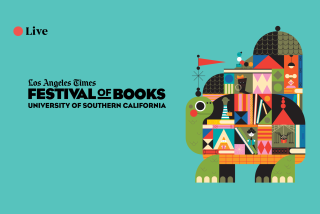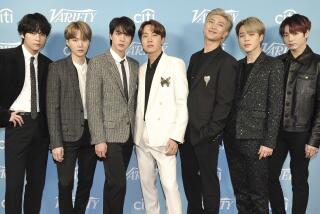Bridging two halves of L.A.
Step into the Libros Schmibros bookstore and lending library and you are, in a sense, stepping inside David Kipen’s brain.
The books that started the Boyle Heights store last year come from Kipen’s personal collection of 7,000 or so used volumes, built over a lifetime of loving good literature. It’s hard to find a bad book in the stacks.
These days, however, Kipen’s brain has been split in half, so to speak, between the Westside and Eastside of L.A.: A big chunk of the Libros collection has been shipped to Westwood. But to Kipen, 48, it doesn’t make much difference, since he thinks of all of L.A. as the Eastside.
“For me, everything east of the ocean is Los Angeles,” he says.
Libros Schmibros, staffed by volunteers whose ranks include writers and professors, is one of the most exciting things to happen in the L.A. book scene in ages. And until Oct. 9, it will be open in two places: at its flagship storefront in Boyle Heights, and in a temporary, “pop-up” store inside the lobby of the Hammer Museum in Westwood.
The two Libros are part of an experiment in bringing together L.A.’s two halves. I went to both to see if it worked, and what the two stores revealed of L.A.’s divisions.
“Do you have any Dostoevski?” asked Liza Kiraz, a young museum employee who was Wednesday’s first customer at the Westwood location.
“Here’s a biography,” Kipen answered. “And there’s a copy of ‘The Possessed’ over here.”
The Westwood Libros is being funded by the Hammer’s Public Engagement program. For Kipen, a book critic who moved to Boyle Heights to start Libros, being back in Westwood is the closing of a circle: He grew up on the Westside, attending Beverly Hills High and haunting Westwood bookstores that have long since closed.
“Dutton’s, Campbell’s, Hunter’s, Westwood Books and Butler-Gabriel across from the UCLA gates,” he said. “This is the neighborhood that made me a book critic.”
I asked Kipen if being a native Westsider operating an Eastside bookstore has given him insights into L.A.’s perpetual Eastside-Westside debate, its geographic and psychic opposites, its Eastside ying and Westside yang.
“I think it’s an arbitrary division,” he said. “The city isn’t like two halves of a walnut. There’s so much mutual incomprehension in L.A. It holds us back.”
It’s true: the East-West divide in L.A. looks bigger than it is, especially to those who rarely cross it. Yet, it’s clearly there, as my journey back between the two Libros revealed.
The Westside location is inside the Hammer, downstairs from its collection of paintings by Degas and Van Gogh, and down the street from towering Wilshire Boulevard condos.
The Eastside location sits a few hundred feet from the 5 Freeway, near rail yards and the aging colossus of L.A.’s oldest general hospital.
At Libros Westside, I watched as assorted moms with kids -- and at least one au pair -- browsed through the art books, novels and plays.
White-haired Eva Barcia came to donate books she’d collected with her late husband, a UCLA Spanish professor, including one by Carlos Fuentes. “He’s a friend,” she said of Fuentes, a giant of Latin American literature.
“Look at this!” said Mary Brown, a story analyst for a movie studio, as her son played on a computer tablet nearby. She had found an old gem: “Death Defying Acts,” a collection of one-act comedies by Woody Allen, David Mamet and Elaine May.
Over at Libros Eastside, the clientele is more proletarian.
Colleen Jaurretche, Libros’ co-director, told me that when school is in session the store fills with an overwhelmingly Latino crowd of high school students. And the other day a utility worker in a hard hat parked his truck in front of the Boyle Heights store.
“He said, ‘I only have a minute. Do you have some Trotsky?’ ” Jaurretche recalled. “He grabbed the book, hopped back on the truck, and off he went.”
But both stores reside in neighborhoods that defy stereotypes.
Like Boyle Heights, Westwood is now the center of an immigrant community -- of Iranians. Kipen had assembled a few books to sell to these readers, including a copy of “The Grapes of Wrath” in Persian. In Boyle Heights, copies of “Las Uvas de la Ira” fly off the shelf.
On Wednesday, the Westside Libros clientele included the poet India Radfar, a New York native who married into an Iranian family.
She told me she’s writing a collection of poems about “what it’s like to be in a Persian-Jewish family without being either Persian or Jewish.”
Over at the Eastside Libros, Alberto Oropeza talked up volunteer Catherine Fryszczyn about trips by train through his native Mexico, and perused the poetry collection. He took a volume by Rumi, a 13th-century Persian poet whose spiritual themes moved him.
Theo Kayser, a 21-year-old employee at the nearby Catholic Worker newspaper and service center, bought “White Noise,” a novel by one of my literary heroes, Don DeLillo.
“Last time I was here I got ‘Underworld,’ ” Kayser said, referring to another DeLillo novel, part of which is set in New York’s version of Boyle Heights -- the Bronx.
A minute later, Will Norrell entered the Boyle Heights store. He’s 62, retired, and a former Santa Monica resident who moved to El Sereno recently, drawn by memories of attending Cal State L.A. -- and cheaper rents.
“Somehow, when you live by the beach, it can feel like everyone around you is on vacation all the time,” he said. In Boyle Heights, he’s among street vendors and bargain shoppers. “It’s refreshing to be here among all these hard-working families.”
Yes, there are deep divisions of income, property values and ethos behind our East-West split. But L.A.’s hunger for books and ideas is universal.
As a reminder of the breadth of L.A.’s literary energy, the artist J. Michael Walker was commissioned by the Hammer to paint a map of literary L.A. that hangs over the Westside Libros’ bookshelves.
Walker’s map has the writers Luis J. Rodriguez and John Fante to the east, and William Faulkner and Ray Bradbury to the west, among many others, all linked by pencil lines representing Wilshire Boulevard and the 10 Freeway.
I liked seeing all those writers up there, almost as much as I liked seeing so many different kinds of readers perusing books in two stores that are, at once, different and alike.
As I left, Kipen handed me a copy of his business card: “Los Angeles is like your brain,” it says. “You only ever use 20% of it. But imagine if we used it all.”
--
More to Read
Sign up for our Book Club newsletter
Get the latest news, events and more from the Los Angeles Times Book Club, and help us get L.A. reading and talking.
You may occasionally receive promotional content from the Los Angeles Times.







